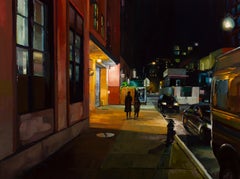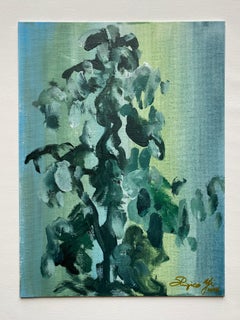Provenance: Babcock Galleries (bears their label verso.) signed verso with artists monogram signature.
Marylyn Dintenfass (born 1943) is an American painter, printmaker, and sculptor. She is primarily known for her oil paintings, which use a dynamic color palette and lexicon of gestural imagery to explore dualities in the human experience and everyday sensual pleasures.
Marylyn Dintenfass was born in 1943 in Brooklyn, New York and spent most of her early years in Brooklyn and then Long Island. She attended Queens College, and graduated in 1965 with a bachelor's degree in Fine Arts. During this time, the artist worked with Abstract Expressionist painter John Ferren and muralist Barse Miller. Marilyn Dintenfass explored new media and developed her own reaction to abstract expressionism with color, line, and gesture. Dintenfass acquired an appreciation for a broad range of materials that led to major sculpture installations composed of ceramic materials, steel, lead, wood, wax and a variety of pigments and epoxies.
Following a tour of museums in Amsterdam, Paris and Rome, the artist made her way to Jerusalem in 1966. During this journey, the artist worked with painter Ruth Bamberger, studied etching and mingled with the artists and intellectuals of the city. The result was Dintenfass's first architectural commission, to design the “Pop Op Disco,” Jerusalem's first disco. This commission allowed her to work with an array of materials to employ shapes, surfaces, textures, colors, and lights, all of which coalesced in her consciousness that would become important components of her mature personal visual vocabulary. Dintenfass also married and started her family during these years.
Art critic Meredith Mendelsohn writes, “Dintenfass uses luscious colors, repetitive forms, and a gestural intensity that combines Abstract Expressionism and Pop Art.”
Dintenfass often works with oil paint on wooden panels fragmented into parts of a grid. "After completing a painting," writes curator and critic Lilly Wei in a study of Dintenfass' work, "Dintenfass literally takes it apart, treating each panel as a discrete entity, exchanging panels between works in an aesthetic mix and match as she searches for interactions and relationships of color and form that satisfy her sense of visual excitement, sparked by the frisson of the dissonant." In an interview with critic Irving Sandler, Dintenfass speaks of the grid as a necessary, formal restraint for the passion of the gestural marks it contains. Joyce Robinson illuminates; “Dintenfass is at heart, though, a painter, and the grid, with its reference to and notion of modular parts, has remained central to her artistic enterprise, functioning as a kind of Apollonian matrix holding in check the exuberant, vividly colored abstractions of this essentially Dionysian artist.”
Lilly Wei adds, "Ultimately, however, Dintenfass is more sensualist than theorist, and her paintings owe much of their allure to their materiality and the dazzle of color. Her array of ripe, radiant, saturated hues—a palette of gorgeous diversity—can be silkily smooth and nuanced; boldly exuberant; or edgily, feverishly discordant."
The artist's abstract imagery usually appears in her work as various forms of stripes or circles arranged across translucent layers of alternating matte and high gloss textures. In a conversation with gallery owner, John Driscoll, Dintenfass likens these symbols to language that predates the written word, saying her "work relates to communication through the visceral channel." Rooted in autobiography, the artist's paintings also examine the contrast between what she calls the “micro” and the “macro.” At times the shapes simultaneously resemble cells under a microscope and visions of the cosmos. Dintenfass' themes explore the dualities of everyday pleasures; depending on the focus of a series, her symbols might conjure characters, candies, car wheels, or paint itself.
Although known for her paintings, Dintenfass was first recognized for her sculptural installations. Her innovative use of mixed media (ceramics, epoxies, wax, pigments, steel, lead, wood, etc.) transformed understanding of what a “ceramic” work of art could be and firmly fixed her position and influence among a generation of mixed media artists expanding the traditional definitions and boundaries of object and materials to create modern art. The results came as architectural reliefs and installation sculpture unique to her organic but structural personal style. Similar to her paintings, Dintenfass developed a modular language of symbols, amalgams of line and curve, which she would combine to create detailed pictographic languages all her own, what she has called “organic alphabets.” As Ted Castle relates, “Ideas are furtive elements, stolen from the matrix, so as to be reformed by human genius into something unforeseen—a poem, a painting, a game of dominoes, a television set, a brick, a tile, a cup. Marylyn Dintenfass is a master of the transformation of ideas into palpable form.”
Dintenfass has also been commissioned to create many large-scale installations, including works for the State of Connecticut Superior Courthouse; the Port Authority of NY 42nd Street Bus Terminal; IBM in Atlanta, Charlotte, and San Jose; The
Baltimore Federal...

